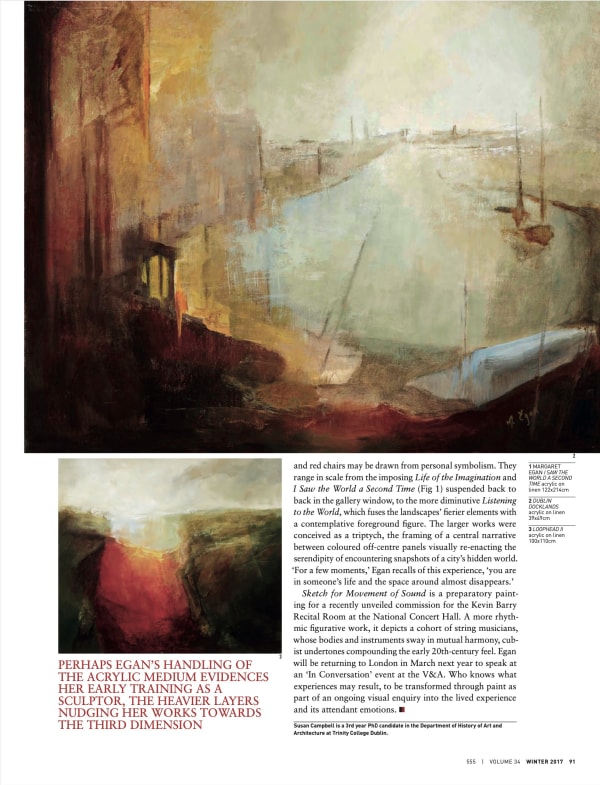Inspired by her proximity to the Dublin coastline and intimate domestic views, Margaret Egan tackles an array of vistas in her current work , writes Susan Campbell.
During a recent visit to London's Tate Modern, Wexford-born artist Margaret Egan glanced out of an upstairs window and was amazed to find she could see right into an enormous block of apartments. These unexpected glimpses of people at home in their interiors inspired her recent exhibition ‘A Slice of Life’ at Solomon Fine Art.
‘It gave me the idea for the figurative pieces... and in a strange way for the landscapes also’, Egan reveals. Encountering these paintings on the gallery walls is to be surprised by far more striking presences than online or print reproduction conveys. In the case of the landscapes, this has much to do with courageous handling of colour, displaying an ease with strong and demanding reds, greens, blues and yellows, choreographed into vibrant relationships and strategically tempered by darker or quieter tones.
Now living by the Dublin coastline, Egan tackles an array of vistas in this latest display of her work. From the Docklands to Seapoint, the Wicklow Hills and Loop Head, all are obscured by skilfully wrought surfaces, with barely perceptible features such as boats, buildings, trees and fences at once suggesting identifiable and mythical places. They seem, somehow, to be captured – but not ossified – within the medium, the art- ist’s technique retaining their atmospheric dynamism. Close looking reveals an orchestration of glazed and matt, thick and thin paint application, and the achievement of equilib- rium within a sensuous and emotive whole. This is what Egan is striving for. Her long-held admiration for JMW Turner is especially evident in Dublin Docklands (Fig 2) which loosely recalls The Decline of the Carthaginian Empire (1817). Other art- ists held in esteem, because she loves how they ‘infused a depth of ‘feeling’ in their work,’ are Egon Schiele, Francis Bacon and Basil Blackshaw.
Perhaps Egan’s handling of the acrylic medium evidences her early training as a sculptor, the heavier layers nudging her works towards the third dimension. A transparent application of crimson over yellow impasto produces a radiant glow in Loop Head II (Fig 3) and here, as in other
‘Loop Head’ works, the two-thirds to one- third, land-to-sky composition penetrates the planet’s interior, hinting of subterra- nean depths and geological time. ‘I always feel the earth absorbs the history it has wit- nessed,’ Egan explains, ‘for me that’s part of landscape, and [as with the] figurative, I try to show what lies beneath the surface."
This comment references the second strand of paintings on display. More clearly inspired by her Tate Modern visit, these are peopled by stripped-back stylised figures, mostly women with an aura of the 1920s, their bobbed hair evok- ing connections with the past. Says Egan, ‘All my figurative pieces come from some experience in my life or the lives of family and friends.’
Acting as a counterpoise to the vitality of the landscapes, the more linear approach to these works communicates a dreamlike timelessness, while recurring motifs such as flowers and red chairs may be drawn from personal symbolism. They range in scale from the imposing Life of the Imagination and I Saw the World a Second Time (Fig 1) suspended back to back in the gallery window, to the more diminutive Listening to the World, which fuses the landscapes’ fierier elements with a contemplative foreground figure. The larger works were conceived as a triptych, the framing of a central narrative between coloured off-centre panels visually re-enacting the serendipity of encountering snapshots of a city’s hidden world.
‘For a few moments,’ Egan recalls of this experience, ‘you are in someone’s life and the space around almost disappears.’
Sketch for Movement of Sound is a preparatory paint- ing for a recently unveiled commission for the Kevin Barry Recital Room at the National Concert Hall. A more rhyth- mic figurative work, it depicts a cohort of string musicians, whose bodies and instruments sway in mutual harmony, cub- ist undertones compounding the early 20th-century feel. Egan will be returning to London in March next year to speak at an ‘In Conversation’ event at the V&A. Who knows what experiences may result, to be transformed through paint as part of an ongoing visual enquiry into the lived experience and its attendant emotions.
Irish Arts Review Volume 34 Winter 2017


